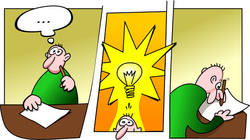
I have had the opportunity to teach “Invention and Creativity” at a local college and discovered first-hand that we all have the potential to be very creative. The course also included understanding US patents and “prior art” as part of the patent process, but, this post will cover only the creativity aspect of idea generation. As the holder of several US patents, I might be considered creative, but having patents is only one small aspect of the creative process. I have to add that none of my patents have made any money! But, that is a discussion for another post.
The class that I was teaching was predominately adult learners with very varied backgrounds. There were men and women from mostly working class and some single mothers who simply wanted to explore the possibilities of being creative and perhaps turning an idea into an income.
Humans have a very long history of being creative. From tools made of stone and then metal, the wheel, to drawings made in caves, we have built our civilization on ideas and the creative process. But, for practical purposes we have to consider what an idea is and how it evolves into a functional concept. We have to begin with what is an idea, and then, is it original, does it have utility, is it practical, can it be accomplished, is it worth the effort, and expenditure of time?
An idea is simply a representation of a thought or question. It can be really simple or extremely complex. Let’s take for example a paper clip. It is simply a piece of wire shaped to hold papers together. But, if we change the shape we can make a hook, a circle, a protractor for drawing, or any other shape that strikes our fancy. And what if we add a rubber band? A device for propulsion, or a musical instrument, may result. An idea has no boundaries unless we make them ourselves. This is the concept of “thinking outside of the box”. And then the question becomes, is it original? I would argue that any idea that is not known to the inventor is original. If someone has never seen a paper clip and forms a wire into a shape to hold papers together, it is original to that inventor. However, once the inventor discovers that it has already been in use, it is now the concept of “reinventing the wheel”. And, there is nothing wrong with replicating an idea; I have done it many times.
So how do we learn to be creative? Well, fortunately we are already wired to make connections between various items. The brain has the ability to synthesize new and novel concepts if we use the resident skills that we already possess. The first necessity is that of observation. Looking carefully at what is around us provides food for the process. And, by looking I mean seeing how materials interact, what are they made of, what is the purpose and utility, and can the item be re-purposed? Work within your knowledge base and use information that is already in your vocabulary. If someone has a skill set in electronics, seeking new ideas can come from that knowledge but can be extended to many other areas. Experiment with what you see. Take it apart and reassemble it and find out what makes it tick. Research any idea to get a feel for what has been done and prevent unnecessary duplication and expand your knowledge base. Use trial and error in your experiments and do some “blue sky thinking”. Imagine what you may create if you don’t do it in a confined thinking space. Collaborate with others if possible and get feedback and considered opinion when possible. Don’t assume that your first idea is the best way to solve a problem. I have fallen prey to this concern and find that coming up with an approach and thinking about it may open up other possibilities that may be better. And most of all, expect failure. I have written a post on failure here, and it is a positive part of the creative concept.
Uncovering your innate ability to invent and to be creative is a process. It takes time, effort, and the willingness to commit to a lifestyle of curiosity and risk. But the reward in making the attempt is worth the effort. Try it, you will like it!

 RSS Feed
RSS Feed
